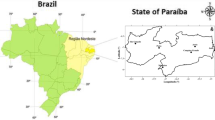Abstract
The study was undertaken to describe the temperature humidity index (THI) dynamics over the Mediterranean basin for the period 1971–2050. The THI combines temperature and humidity into a single value, and has been widely used to predict the effects of environmental warmth in farm animals. The analysis was based on daily outputs of the temperature and relative humidity from the Max Planck Institute data using the Intergovernmental Panel on Climate Change Special Report Emission Scenario A1B. Data revealed a gradual increase of both annual and seasonal THI during the period under investigation and a strong heterogeneity of the Mediterranean area. In particular, the analysis indicated that Spain, southern France and Italy should be expected to undergo the highest THI increase, which in the last decade under study (2041–2050) will range between 3 and 4 units. However, only during summer months the area presents characteristics indicating risk of thermal (heat) stress for farm animals. In this regard, scenario maps relative to the summer season suggested an enlargement of the areas in the basin where summer THI values will likely cause thermal discomfort in farm animals. In conclusion, the study indicated that the Mediterranean basin is likely to undergo THI changes, which may aggravate the consequences of hot weather on animal welfare, performances, health and survival and may help farmers, nutritionists, veterinarians, and policy-makers to develop appropriate adaptation strategies to limit consequences of climate change for the livestock sector in the Mediterranean countries.





Similar content being viewed by others
References
Bernabucci U, Lacetera N, Baumgard LH, Rhoads RP, Ronchi B, Nardone A (2010) Metabolic and hormonal acclimation to heat stress in domesticated ruminants. Animal 4:1167–1183
Bohmanova J, Misztal I, Cole JB (2007) Temperature–humidity indices as indicator of milk production losses due to heat stress. J Dairy Sci 90:1947–1956
Bolle HJ (2002) Mediterranean climate: variability and trends. Springer, New York
Bouraoui R, Lahmar M, Majdoub A, Djemali M, Belyea R (2002) The relationship of temperature-humidity index with milk production of dairy cows in a Mediterranean climate. Anim Res 51:479–491
de Rancourt M, Mottet A (2006) Mediterranean animal production: development or decline? Options Méditerr 78:13–22
Dubois C, Somot S, Calmanti S, Carillo A, Déqué M, Dell’Aquilla A, Elizalde A, Gualdi S, Jacob D, L’Hévéder B, Li L, Oddo P, Sannino G, Scoccimarro E, Sevault F (2011) Future projections of the surface heat and water budgets of the Mediterranean Sea in an ensemble of coupled atmosphere-ocean regional climate models. Clim Dynam. doi:10.1007/s00382-011-1261-4
Frei C, Schär C (1998) A precipitation climatology of the Alps from high-resolution rain-gauge observations. Int J Climatol 18:873–900
Gao X, Giorgi F (2008) Increased aridity in the Mediterranean region under greenhouse gas forcing estimated from high resolution simulations with a regional climate model. Glob Planet Change 62:195–209
Gaughan JB, Lacetera N, Valtorta SE, Khalifa HH, Hahn GL, Mader TL (2009) Response of domestic animals to climate challenges. In: Ebi KL, Burton I, McGregor GR (eds) Biometeorology for adaptation to climate variability and change. Springer, Heidelberg, pp 131–170
Giorgi F (2006) Climate change hot-spots. Geophys Res Lett 33:L08707
Giorgi F, Bi X (2005) Update regional precipitation and temperature changes for the 21st century from ensembles of recent AOGCM simulations. Geophys Res Lett 32 L21715
Goubanova K, Li L (2007) Extremes in temperature and precipitation around the Mediterranean basin in an ensemble of future climate scenario simulations. Glob Planet Chang 57:27–42
Hahn GL, Mader TL, Eigenberg RA (2003) Perspective on development of thermal indices for animal studies and management. EAAP Technic Ser 7:31–44
Heirting E, Jacobeit J (2008) Downscaling future climate change: Temperature scenarios for the Mediterranean area. Glob Planet Chang 63:127–131
IPCC (2007) Climate change 2007. Physical Science Basis, Cambridge
Lionello P, Malanotte-Rizzoli P, Boscolo R, Alpert P, Artale V, Li L, Luterbacher J, May W, Trigo R, Tsimplis M, Ulbrich U, Xoplaki E (2006) The Mediterranean climate: an overview of the main characteristics and issues. In: Lionello P, Malanotte-Rizzoli P, Boscolo R (eds) Mediterranean climate variability. Elsevier, Amsterdam, pp 1–26
Lionello P, Boldrin U, Giorgi F (2008) Future changes in cyclone climatology over Europe as inferred from a regional climate simulation. Clim Dyn 30:657–671
Lucas EM, Randall JM, Meneses JF (2000) Potential for evaporative cooling during heat stress periods in pig production in Portugal (Alentejo). J Agric Eng Res 76:363–371
Nardone A, Ronchi B, Lacetera N, Ranieri MS, Bernabucci U (2010) Effects of climate changes on animal production and sustainability of livestock systems. Liv Sci 130:57–69
Nienaber JA, Hahn GL (2007) Livestock production system management responses to thermal challenges. Int J Biometeorol 52:149–157
Paeth H, Hense A (2005) Mean versus extreme climate in the Mediterranean region and its sensitivity to future global warming conditions. Meteorol Z 14:329–347
Segnalini M, Nardone A, Bernabucci U, Vitali A, Ronchi B, Lacetera N (2011) Dynamics of the temperature-humidity index in the Mediterranean basin. Int J Biometeorol 55:253–263
Somot S, Sevault F, Déqué M, Crépon M (2008) 21st century climate change scenario for the Mediterranean using a coupled atmosphere-ocean regional climate model. Glob Planet Chang 63:112–126
Thornton P, Herrero M, Freeman A, Mwai O, Rege E, Jones P, McDermott J (2007) Vulnerability, climate change and livestock—research opportunities and challenges for poverty alleviation. SAT eJournal|ejournal.icrisat.org 4:1–23
Vitali A, Segnalini M, Bertocchi L, Bernabucci U, Nardone A, Lacetera N (2009) Seasonal pattern of mortality and relationships between mortality and temperature humidity index in dairy cows. J Dairy Sci 92:3781–3790
WMO (1959) Technical regulations, no 49, volume 1 (bd. 2), 2nd edn. World Meteorological Organization, Geneva
Acknowledgements
This study was financially supported by EU (CIRCE Integrated Project # 036961), and Università degli Studi della Tuscia.
Author information
Authors and Affiliations
Corresponding author
Rights and permissions
About this article
Cite this article
Segnalini, M., Bernabucci, U., Vitali, A. et al. Temperature humidity index scenarios in the Mediterranean basin. Int J Biometeorol 57, 451–458 (2013). https://doi.org/10.1007/s00484-012-0571-5
Received:
Revised:
Accepted:
Published:
Issue Date:
DOI: https://doi.org/10.1007/s00484-012-0571-5




